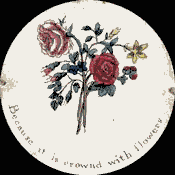Thaumatrope


A thaumatrope is an optical toy that was popular in the 19th century. A disk with a picture on each side is attached to two pieces of string. When the strings are twirled quickly between the fingers the two pictures appear to blend into one due to the persistence of vision.[1]
Thaumatropes can provide an illusion of motion when two stages of a figure in motion are depicted, but no examples are known to have been produced before the introduction of the first widespread animation device: the phénakisticope.
Examples of common thaumatrope pictures include a bare tree on one side of the disk, and its leaves on the other, or a bird on one side and a cage on the other. They often also included riddles or short poems, with one line on each side.
Thaumatropes are often seen as important antecedents of motion pictures and in particular of animation. This is partly due to many film historians' belief that the associated theory of persistence of vision explains the physiological basis for movies, although this was disproved in 1912.
Etymology
The coined name translates roughly as "wonder turner", from Ancient Greek: θαῦμα "wonder" and τρόπος "turn".
Invention
In 2012, it was reported that a prehistoric thaumatrope had been discovered in the Chauvet Caves in France,[2] but it is very uncertain if this little disc was actually perceived as a thaumatrope when it was made.
The invention of the thaumatrope is usually credited to John Ayrton Paris. Paris was said to have used one to demonstrate persistence of vision to the Royal College of Physicians in London in 1824. Charles Babbage recalled in 1864 that the thaumatrope was invented by the geologist William Henry Fitton after he (Babbage) had told Fitton how the astronomer John Herschel had made him see two sides of a shilling at once by spinning it.[3]
Commercial production
The first commercial thaumatrope was registered at Stationers' Hall on April 2, 1825 and published by W. Phillips in London as 'The Thaumatrope; being Rounds of Amusement or How to Please and Surprise By Turns', sold in boxes of 12 or 18 discs. It included a sheet with mottoes or riddles for each disc, often with a political meaning. Paris was widely regarded as the author, but wasn't mentioned on the product or its packaging and he later claimed in a letter to Michael Faraday "I was first induced to publish it, at the earnest desire of my late friend Wm Phillips. (...) I may add that I never put my name to it".[4]
The steep price of a set (seven shilling for 12 discs or half a guinea for 18) was criticized, half a guinea would have been about a week's pay for an average worker.[4] It was also defended: its inventor should be able to earn something from his invention while it was new, before it was widely copied as seen before with the kaleidoscope.[5] Paris later claimed he gained £150,- from its sales in the United Kingdom.[4]
As expected pirate copies soon became common and were much cheaper. The 'Thaumatropical Amusement' was available in boxes of six discs for one shilling.[4]
Although the toy became popular original copies are now very rare; only one set produced W. Phillips is currently known to be in the collection of Richard Balzer and a single disc at the Cinematheque Francaise.[4]
Other early publishers across the continent included Alphonse Giroux & Compagnie in France and Trentsensky in Austria.
Thaumatropes in popular culture
In the 2013 video game "BioShock Infinite" the bird and the cage thaumatrope is used several times.
In the 2011 Martin Scorsese film Hugo, the final scene begins in the middle of a conversation about cinema precursors, including the thaumatrope.
In the 2006 Christopher Nolan film The Prestige, Michael Caine's character repeatedly uses a thaumatrope as a way of explaining persistence of vision.
In the 1999 Tim Burton film "Sleepy Hollow" a bird and cage thaumatrope is demonstrated by Johnny Depp.
The 1827 book Philosophy in Sport made Science in Earnest, being an attempt to illustrate the first principles of natural philosophy by the aid of popular toys and sports[6] featured the thaumatrope and warned against inferior copies. The chapter head was illustrated with a drawing by George Cruikshank of a man demonstrating the thaumatrop to a girl and a boy. It was first published anonymously, but posthumous editions were credited to John Ayrton Paris.
See also
References
| Wikimedia Commons has media related to Thaumatrope. |
- ↑ Persistence of vision
- ↑ Daily Mail: "A night at the pictures, caveman style"
- ↑ Babbage, Charles (1864). Passages from the Life of a Philosopher. p. 189.
- 1 2 3 4 5 Herbert, Stephen. "Wheel of Life - The Taumatrope".
- ↑ "The New monthly magazine". 1825. p. 177.
- ↑ paris, john ayrton (1827). Philosophy in Sport made Science in Earnest. p. 338.
External links
- A collection of animated thaumatropes – The Richard Balzer Collection
- Thaumatrope simulation
- Demonstration
- BBC Film Network – The Persistent Resistance of Vision – short film parodying the thaumatrope
- The caveman cartoons: How prehistoric artists make their paintings MOVE